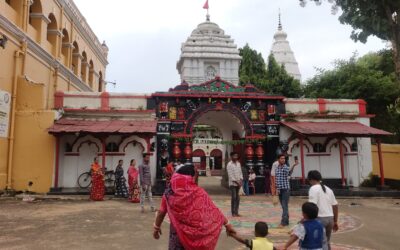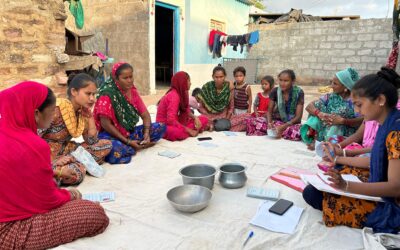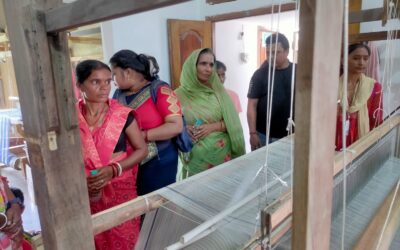Van Gujjars are a community located in the northern part of India, along the Ganga and Yamuna rivers. They are known for their traditional Gojri buffalo.

Traditionally, Van Gujjars migrate up to the Himalayan Bugyals (higher altitude wetlands) during summers. However, selling milk becomes difficult for them as they cannot come down to the market every day. As a result, they usually make paneer1 every third day and bring it down to the nearby markets in buckets. This is the responsibility of the youngest male member of the family.
Also read: Van Gujjar Settlements In Uttarakhand
For instance, Mohamad Yusufji, who lives in Sahaspur near Vikasnagar and migrates to Panjala Bugyal. He sells paneer in markets such as Nitwad, More, Badkot, and Mohagaon. Nowadays, the Forest Department does not allow them to make mawa2 as it requires more firewood. Therefore, paneer made today, yesterday, and the day before is packed together in a cloth. His younger brother, Safee takes it down in a bucket. He likes listening to songs and Baiths uploaded on YouTube. So he charges his phone using solar energy earlier in the day to keep it ready.
Today, he is carrying all the 30-40 kg of paneer in the bucket down the mountain to the Nitwad market. He will then go to the dairy where he will sell some paneer as required. After that, he will visit some fellow villagers who asked for paneer. If there is still some left, he will go to his friend in Nitwad, take his bike from there, and transport the paneer to Badkot to sell it there. He meets some Gujjars there, and they decide to go up together. The weekdays are fixed when each family will go to the market. This way, everyone can sell their paneer for a good amount.

Near Rudraprayag, in Panvai Kanta Bugyal, there are fewer restrictions from the Forest Department. So the Kasana (type of Gojri Gotra) family makes mawa and sells it in nearby markets such as Ghansiyali. People sell Mawa in mithaiwala shops for higher prices and it involves a lot of processing. They make it with leftover milk after making paneer. To make mawa, one has to boil the milk. And keep stirring it for a long time until it reduces to a thick paste of milky goodness. It is then packed well and sold to mithaiwalas who use it to make barfis, desserts, and mithais. Additionally, people here sell ghee at relatively higher prices compared to the price in plains.
Gulam Rassol, who goes to Uttarkashi, explains, “No matter which month the gojri buffalo is in, she will give double the quantity of milk.” He adds, “250 grams of milk from Bugyal is almost equal to 1 kg of milk in the plains, resulting in more paneer, mawa, and ghee.” He smiles while sharing how much everyone loves makkhan from the mountains. Further explaining the physical properties of milk, he says, “Pahad ka dudh ubaal ke bahar rakh do to 10 din tak nahi kharab hota”. (The milk from mountains, if you boil once, won’t spoil for 10 days).

Barsin Kasana, who goes to Panwai Kanta Bugyal and lives in Kunao during winters, says they make mawa every 3rd day and take it to the market. He mentions that mawa is sold at a higher price in Bugyals than in the plains.
In the plains (winter homes), people mostly sell milk to their known dairy or house-to-house if they are close to the city. People from Kunao go to Rishikesh. From Kushrela to Narendra Nagar, from Doiwala to Dehradun. From Jattowala to Herbatpur, from Simbal Strot to Haridwar, and so on. Van Gujjars and Baniyas share a long-standing relationship to purchase the milk, process it, and sell it forward. The Baniyas have manufacturing units where they make ghee and paneer, which they then sell to dairies. Most of the sedentarized Gujjars sell their milk to the Baniyas, with 70 to 80% of its contribution by Gendikhata and nearby settlements. This milk is further brought to Rishikesh.
During summers, another group of Gujjars travels to Khaddar ka Tapu in Bijnore, Uttarakhand. Most of these people are from Gendikhata and Khattas around Haridwar. Some individuals from Doiwala and Kunao have also chosen this migration route for the past 8-9 years. They continue to sell milk to the same Baniya who purchases milk from them during their winter homes. They do so because milk prices drop in Bijnore, and maintaining this relationship with the Baniyas is beneficial. From their end, Baniyas try to offer them higher prices but cut the amount of petrol needed to travel to Bijnore every day. Nonetheless, the Gujjars consider this option more profitable than selling in Bijnore. The Baniyas make the effort to travel twice a day to collect the milk and keep the supply chain running.

Aftab, while explaining the difference in milk, says, “There is a slight difference in milk, not much.” He mentions that even without providing paral and chokker anymore, and with buffaloes grazing on grasses by themselves, there is not much difference in milk quality between the two regions. He adds that the grasses from Khaddar are not significantly different from the grasses in the mountains. Bijnore is comparatively closer and more accessible to Gujjars than the mountains, so many of them have changed their routes and chosen it.
In this way, milk exchange changes from dera to dera throughout the year. Whether it’s adapting to sell milk in the mountains or building relationships in Khaddar, Gujjars have always found a way to maintain the milk chains and build their livelihoods on them.

References :
- Paneer is a fresh acid-set cheese common in the Indian subcontinent (India, Bangladesh, Bhutan, Maldives, Nepal, Pakistan and Sri Lanka) made from full-fat buffalo milk or cow milk.
- Mawa is a dairy food people widely use in the cuisines of the Indian subcontinent, encompassing India, Nepal, Bangladesh and Pakistan. It is made of either dried whole milk or milk thickened by heating in an open iron pan.




0 Comments
Trackbacks/Pingbacks